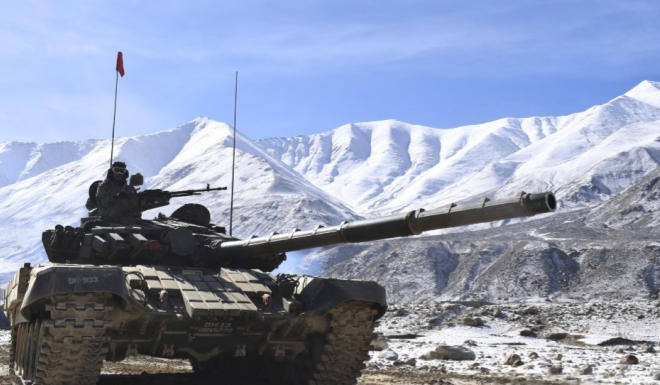Published 13:50 IST, June 29th 2024
What Led To T-72 Tank Sink In Flash Floods Near LAC In Ladakh
The T-72, a Soviet-designed main battle tank introduced in 1971 and continually upgraded, remains a crucial part of India's armored fleet.

Ladakh, India: In a heart-wrenching tragedy, five Indian Army personnel lost their lives when they were swept away while crossing a river in a T-72 tank near the Line of Actual Control (LAC) in the Nyoma-Chushul area of Ladakh. The incident occurred around 1 am on Saturday near Mandir Morh, approximately 148 kilometres from Leh, during a routine exercise.
According to Defence officials, the unfortunate tank was manned by a crew comprising one Junior Commissioned Officer (JCO) and four jawans. The tank sank due to a sudden surge in water levels, leading to the tragic loss of lives. "Five Indian Army personnel, including one JCO and four jawans, lost their lives in a mishap during a river crossing exercise last evening in the Daulat Beg Oldie area," officials confirmed. All five bodies have since been recovered.
The T-72 Tank: A Profile
The T-72 is a Soviet-designed main battle tank that entered production in 1971. Despite its age, it remains a vital part of many armed forces worldwide, including India's. The tank has been continually upgraded to enhance its combat capabilities. The modernized version, known as the CI-Ajeya, boasts features such as a Global Positioning System (GPS), Explosive Reactive Armour (ERA), and an Integrated Fire Detection and Suppression System (IFDSS). These upgrades are aimed at maintaining the tank's relevance in contemporary combat scenarios.

Speaking exclusively with Republic, Captain (retd) SB Tyagi explained the complexities of river-crossing operations with the T-72 tank. “The T-72 is designed to cross rivers up to 16 Feet deep submerged using a small diameter snorkel assembled onsite. If the engine stops underwater, it must be restarted within six or seven seconds, or the tank’s engine compartment will be flooded due to pressure loss.”
According to Captain Tyagi, the T-72 crew members are individually supplied with simple rebreather chest-pack apparatuses for emergency situations. “The snorkelling procedure is considered dangerous but is important for maintaining operational mobility”, the retired officer added.
Circumstances Leading to the Tragedy
Sources indicate that the tank, with five soldiers on board, was crossing the river when it was caught in flash floods. The rapid increase in water levels overwhelmed the tank, causing it to sink. "A mishap took place in the Daulat Beg Oldie area of Ladakh during a tank exercise of crossing the river yesterday in the sector due to a sudden increase in water levels there. Loss of lives of Army personnel is feared. More details are awaited," Defence officials had earlier stated. Initially, officials mentioned that one person had been located, while the search for the others was ongoing.

For years, the Indian Army has faced challenges in modernizing its T-72 tanks. Initially relying on the indigenous Arjun tank program, the Army shifted its focus to upgrading the T-72 fleet due to delays in the Arjun program. The Operation Rhino plan aimed at re-equipping 1,500 T-72M1 tanks includes installing advanced fire control systems, thermal imagers, and navigation systems from international partners. The tanks are also being equipped with improved fire detection, suppression systems, and laser warning systems.
This incident serves as a stark reminder of the inherent risks faced by military personnel in the line of duty. The loss of five brave soldiers is a profound tragedy for the Indian Army and the nation. The sacrifices of these soldiers underscore the ongoing challenges and dangers associated with maintaining security and operational readiness in hostile environments.
Updated 14:52 IST, June 29th 2024


